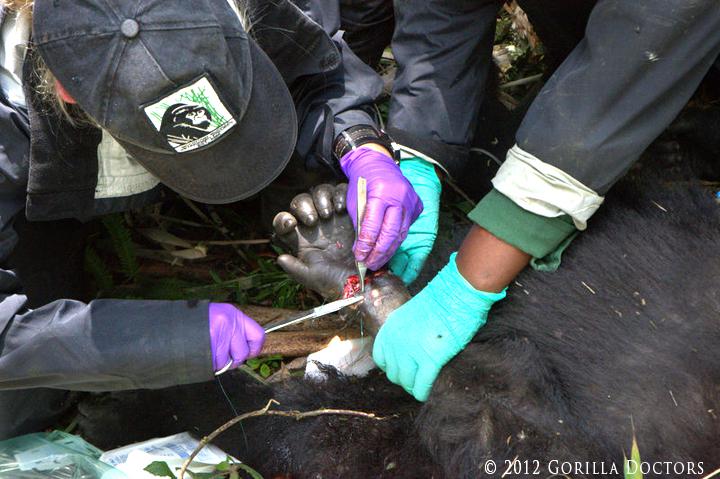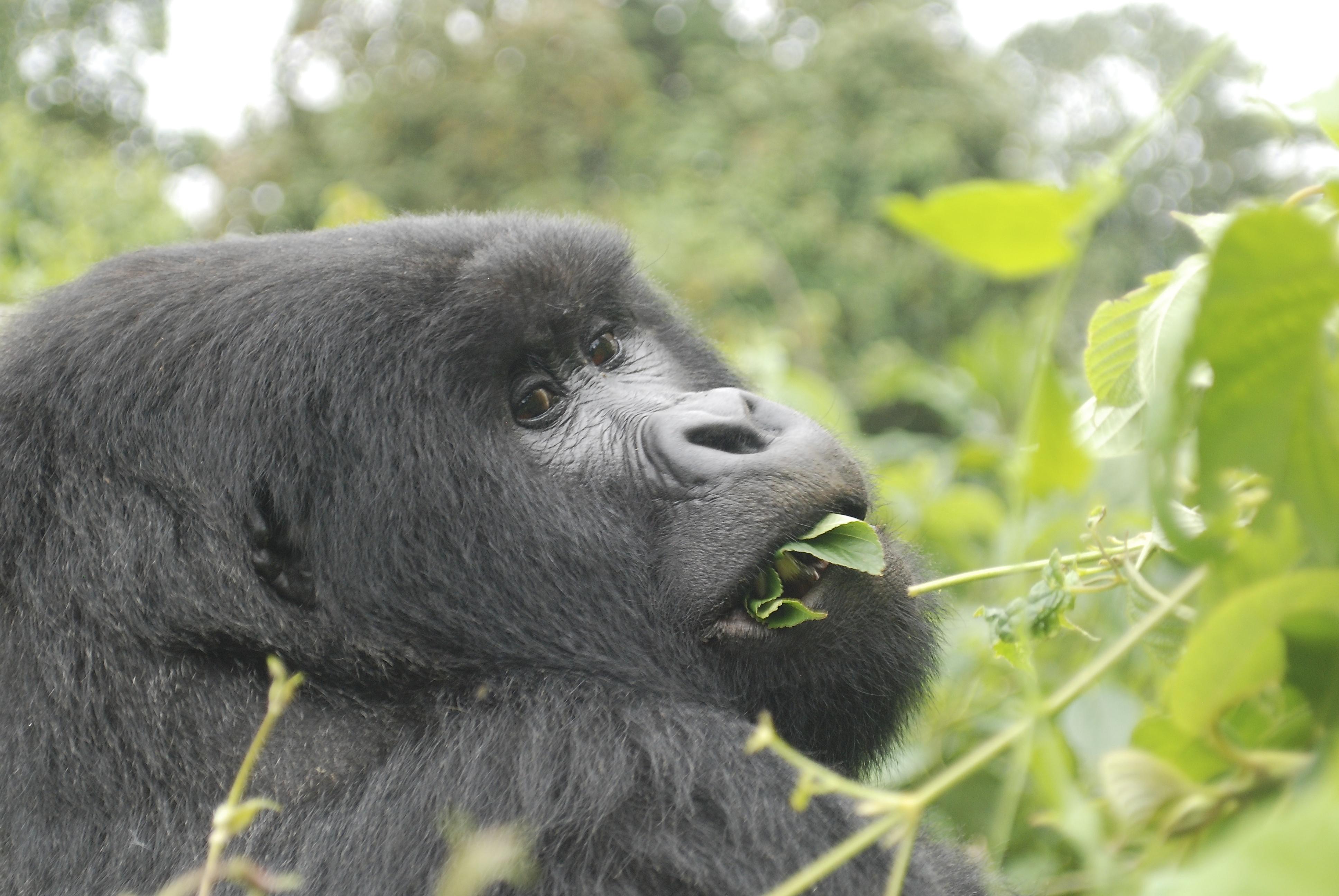Jan Ramer is not your typical veterinarian. For one thing, she makes house calls, which might involve exhausting six-hour hikes through sloping, high-altitude rainforests just to reach her patients: critically endangered mountain gorillas. Then, to have a chance at successful treatment, Ramer’s team of vets, rangers, trackers, and assistants must tranquilize the sick animal without raising the ire of the silverback—the group’s dominant male, who can weigh in at 400 pounds or more.
On one ill-fated outing, a leery silverback didn’t appreciate the intrusion on his family, so he sunk his canines into a guard’s shoulder before running off into the forest, leaving the man in shock and the team with an aborted mission. (The guard survived and still works with gorillas.) Oftentimes though, the team is successful. They treat ailments such as respiratory infections and remove hunters’ snares.

Courtesy of Gorilla Doctors, © Gorilla Doctors, www.gorilladoctors.org
Ramer is the regional manager of a nonprofit called Gorilla Doctors, based in the town of Musanze, about 90 kilometers from Kigali, Rwanda’s capital. Musanze serves as a jumping-off point for gorilla trekking in the Virunga Mountains, and it’s brimful with gorilla-themed tourist hotels and conservation organizations.
In the mid 1980s, the first “Gorilla Doctor,” James Foster, answered a call from Dian Fossey to bring veterinary care to the few hundred remaining mountain gorillas in Rwanda at the time. The vets now treat wild gorillas in the eastern Democratic Republic of Congo and in Uganda as well.
While ordinary conservation methods aim to minimize human contact with wildlife, the “extreme conservation” that Ramer and her colleagues practice turns that model on its head, seeking instead to make contact with the animals in order to save them.
As if the tough conditions and ornery patients weren’t enough, mountain gorilla territory in Congo’s North Kivu Province has a long history of violence and political instability. Recently the conflict has become a siege between the Congolese army supported by U.N. forces and around a dozen armed groups. Success on the battlefield against one enemy, such as the M23 rebels vanquished in late 2013, only seems to open the rugged North Kivu to a suite of other foes: relatively well-organized militias, including the Democratic Forces for the Liberation of Rwanda and Allied Democratic Forces of Congo; more amorphous and loosely allied Mai Mai groups; and outright bandits capitalizing on the chaos in the region. In April, Emmanuel de Merode, the director of Virunga National Park, survived gunshot wounds to the chest and legs from roving thugs who attacked him as he drove from Goma to park headquarters. More than 140 of the park’s rangers have been killed in the past 10 years.
The swirling mix of combatants pursue a variety of military, economic, and political aims, and many have rumored—or in some cases documented—links to other countries in the region, including next-door neighbors Uganda and Rwanda. But the one commonality tying them together is violence. It keeps alive thriving wildlife trade and bush meat markets for poachers; brings rape, torture, and other horrors of war to people’s doorsteps; and ensures that the region’s mainly subsistence farmers struggle to feed their families, even on Kivu’s fertile volcanic soils, as harvest after harvest is disrupted by war.
The vets’ work is extreme in almost every way imaginable. It’s expensive and dangerous, invasive and sometimes experimental, and it can change gorillas’ natural behavior. But for the fewer than 900 mountain gorillas in the wild, it’s also been an essential lifeline that’s working.
“Mountain gorillas are the only great ape population that’s growing,” says Ramer. “The only one.” There’s a hint of pride in her voice. Gorilla Doctors has something to do with that, and the group has the data to back it up.
In 2011, biologist Martha Robbins and her colleagues searched for trends in Virunga mountain gorilla populations using more than 40 years of data. They looked at growth rates for unhabituated gorillas, which had never been studied or administered veterinary care. And they looked the numbers of habituated gorillas—the groups that tourists and scientists visit and that thus can also receive medical attention.
While unhabituated gorilla numbers were declining slightly, Robbins found that the habituated group numbers were on the rise at around 4 percent a year. That’s an extraordinary clip for such a slow-reproducing species, one in which a typical gorilla mother has a single baby only every four to five years.
But why such a big difference between habituated and unhabituated gorillas? It certainly helps that guards protect habituated gorillas from poaching from sunup to sundown, seven days a week. But when Robbins looked at the Gorilla Doctors’ treatment records and estimated population changes that would have occurred if, for example, they hadn’t treated an infected snare wound and the animal had died, Robbins and her team figured that almost half of the habituated gorilla population’s growth could be due to the veterinary care.

Courtesy of Gorilla Doctors, © Gorilla Doctors, www.gorilladoctors.org
That then raises the question—if habituating gorillas helps so much, then why not habituate all of them? Limited resources, for one, says Robbins.
To achieve this “remarkable” growth rate, “It has taken a massive amount of effort,” she adds. The habituation process alone takes two years of daily visits before a gorilla family is ready to host photo-snapping tourists, inquisitive field researchers, or tranquilizer-toting veterinarians.*
And then there’s the possibility of disease transmission. Because we share 98 to 99 percent of our DNA with gorillas, depending on how you slice the double helix, we’re susceptible to a lot of the same diseases. Even simple human chest colds could lay waste to naïve ape immune systems, and increasing the number of gorillas in contact with people increases the chances that they’ll get sick, which could devastate their already-fragile numbers.
These complications point to the need to complement the Gorilla Doctors’ work with conventional, less intensive conservation tactics—cracking down on poaching, for example. “If there were no snares set in the Virungas, we would not need snare removals,” she says. And more robust traditional strategies could help both unhabituated and habituated gorilla numbers grow, not to mention being more cost effective.
Still, Robbins points out that “efforts of last resort,” such as near-constant guarding and vet care, have been, and remain, essential to mountain gorilla survival. “We have a conservation success story,” she adds. But with only around 880 animals left, that story is far from over. For the story to stay on the same trajectory, few conservation measures can be considered too extreme.

Courtesy of Gorilla Doctors, © Gorilla Doctors, www.gorilladoctors.org
*Correction, Jan. 14, 2015, 4:30 p.m.: This article originally misstated how many years it takes for a gorilla family to be habituated to humans. It takes about two years, not five. (Return.)
